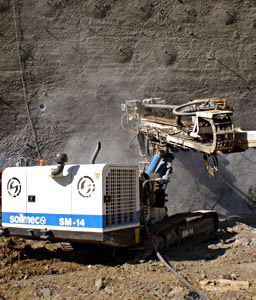|
 |
Rock and Soil Anchors
Rock and soil anchors offer an economical solution to temporary or permanent stability or support problems. Designed to withstand lateral and uplift forces, these structural members are typically used with temporary, deep excavation support systems, as a part of permanent retaining walls, for dam stabilization or to resist wind-produced uplift
forces.
Ground Anchors are load transfer systems consisting of . . .
• Anchor in stable ground
• Long tendon
• Connection to structure
Ground Anchor Applications
• Lateral support of walls
• Resistance of hydraulic uplift
• Stabilization of landslides
• Resistance to overturning
Ground Anchor Design Steps
1. Establish geotechnical conditions
2. Establish loading diagram and construction sequence
3. Develop trial anchor capacity
4. Develop anchor zone design
5. Check overall stability
6. Field test anchors
Soil Nailing
Soil Nailing is an in situ technique for reinforcing, stabilizing and retaining excavations and deep cuts through the introduction of relatively small, closely spaced inclusions (usually steel bars) into a soil mass, the face of which is then locally stabilized. A zone of reinforced ground results that functions as a soil retention system.
Soil Nailing Applications
• Temporary and permanent excavation support/retaining walls
• Stabilization of tunnel portals
• Stabilization of slopes
• Repair of retaining walls
Soil Nails May Consist of:
• Reinforcing bars
• Steel tubing
• Steel angles
Types of Soil Nail
• Driven nail
• Grouted nail
• Jet grouted nail
Corrosion Protection
Corrosion protection is necessary for long-term temporary and/or permanent works
• Epoxy Coatings
• Polyethylene Sheathing
• Cathodic Protection
Types of Facing
The type of facing depends on application and soil type. Current facings include:
• Shotcrete, generally reinforced with either
o Welded wire mesh
o Rebar
o Steel or polyester fibers
• Prefabricated concrete or steel panels
• Cathodic Protection
Suitable Application Media
Soil nailing is possible in a wide range of materials including:
• Clays
• Sandy soils
• Weathered rock; tallus slope deposits
• Heterogeneous and stratified soils
Soil nailing is not practical in:
• Soft, plastic clays
• Organics/Peat
• Loose (N 10), low density and/or saturated soils
• Fills (rubble, cinder, ash, etc.)
Geotechnical Parameters and Design Considerations for Soil Nailing
• Mechanical properties of soil
o Soil type(s) and density
o Moisture content
o Soil stratification
• Groundwater condition, seasonal changes and hydrology
Soil Nailing Drainage Systems
Drainage systems are incorporated into the nailed wall, reducing liquid pressure and preventing saturation of the reinforced ground. Drainage systems include:
• Geotextile facing
o Drilled in place relief wells
• Slotted plastic collection piping
Surface drainage control above and behind the retaining wall is also critical to the system.
Soil Nailing Design Steps
1. Perform geotechnical site investigation
2. Evaluate excavation/nailed wall geometry
3. Check wall stability - internal/external
4. Incorporate drainage control system with nail wall design
5. Finalize nailing layout and work sequence
Soil Nailing Quality Control
• Nailing installation sequence
o Verification testing - pull test to verify design strengths
o Progressive monitoring for design performance
• Conventional movement monitoring
o Inclinometers
o Optical survey of fixed targets
• Shotcrete
o Thickness
o Strength
Back to page |